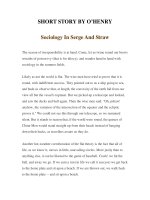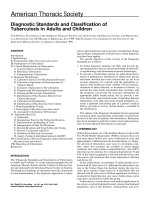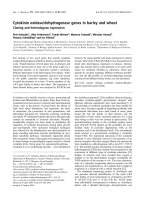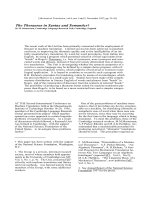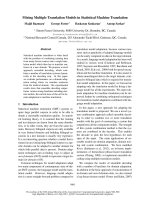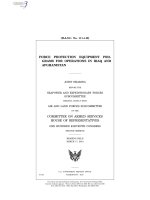DERMAL ABSORPTION MODELS IN TOXICOLOGY AND PHARMACOLOGY doc
Bạn đang xem bản rút gọn của tài liệu. Xem và tải ngay bản đầy đủ của tài liệu tại đây (7.53 MB, 387 trang )
TLFeBOOK
DERMAL ABSORPTION
MODELS IN TOXICOLOGY
AND PHARMACOLOGY
DERMAL ABSORPTION
MODELS IN TOXICOLOGY
AND PHARMACOLOGY
Edited by
Jim E. Riviere
North Carolina State University
Raleigh, North Carolina
A CRC title, part of the Taylor & Francis imprint, a member of the
Taylor & Francis Group, the academic division of T&F Informa plc.
Boca Raton London New York
Published in 2006 by
CRC Press
Taylor & Francis Group
6000 Broken Sound Parkway NW, Suite 300
Boca Raton, FL 33487-2742
© 2006 by Taylor & Francis Group, LLC
CRC Press is an imprint of Taylor & Francis Group
No claim to original U.S. Government works
Printed in the United States of America on acid-free paper
10 987654321
International Standard Book Number-10: 0-415-70036-1 (Hardcover)
International Standard Book Number-13: 978-0-415-70036-8 (Hardcover)
Library of Congress Card Number 2005041842
This book contains information obtained from authentic and highly regarded sources. Reprinted material is
quoted with permission, and sources are indicated. A wide variety of references are listed. Reasonable efforts
have been made to publish reliable data and information, but the author and the publisher cannot assume
responsibility for the validity of all materials or for the consequences of their use.
No part of this book may be reprinted, reproduced, transmitted, or utilized in any form by any electronic,
mechanical, or other means, now known or hereafter invented, including photocopying, microfilming, and
recording, or in any information storage or retrieval system, without written permission from the publishers.
For permission to photocopy or use material electronically from this work, please access www.copyright.com
( or contact the Copyright Clearance Center, Inc. (CCC) 222 Rosewood Drive,
Danvers, MA 01923, 978-750-8400. CCC is a not-for-profit organization that provides licenses and registration
for a variety of users. For organizations that have been granted a photocopy license by the CCC, a separate
system of payment has been arranged.
Trademark Notice:
Product or corporate names may be trademarks or registered trademarks, and are used only
for identification and explanation without intent to infringe.
Library of Congress Cataloging-in-Publication Data
Dermal absorption models in toxicology and pharmacology / edited by Jim E. Riviere.
p. ; cm.
Includes bibliographical references and index.
ISBN 0-415-70036-1 (alk. paper)
1. Dermatotoxicology Mathematical models. 2. Dermatologic agents Toxicology. 3. Health risk
assessment. 4. Skin absorption. I. Riviere, J. Edmond (Jim Edmond)
[DNLM: 1. Skin Absorption. 2. Models, Theoretical. 3. Risk Assessment. 4. Toxicology methods.
WR 102 D4345 2005]
RL803.D445 2005
616.5 dc22 2005041842
Visit the Taylor & Francis Web site at
and the CRC Press Web site at
Taylor & Francis Group
is the Academic Division of T&F Informa plc.
TF1776_Discl.fm Page 1 Friday, July 22, 2005 6:54 AM
Preface
Paradoxically, skin is both a primary barrier to systemic absorption of topically
exposed chemicals and a portal to systemic delivery of transdermal medicaments.
Knowledge of the factors that determine both extent and rate of chemical flux across
the skin is an important component of both toxicology and pharmacology studies.
The aim of this book is to provide current approaches and techniques by which
dermal absorption may be quantitated utilizing end points relative to these two
disciplines. There are a number of different experimental methods and mathematical
modeling approaches in use today. Most are rooted in disciplines outside toxicology,
yet their methods are applied to dermal absorption. This book serves as a bridge
between general considerations in risk assessment and systemic toxicology texts.
The first four chapters introduce and overview both the structure and function
of skin as well as the
in vitro
and
in vivo
experimental approaches available for
assessing dermal absorption of drugs and chemicals. This is followed by mathemat-
ical or so-called
in silico
models to quantitating percutaneous absorption, including
physiological-based pharmacokinetic modeling and quantitative structure–activity
relationship methods. The next chapters deal with applications of these techniques
to the risk assessment process. The remainder of the book discusses scenarios in
which unique properties of the chemicals studied or the matrix in which they are
exposed must be considered, including volatile compounds or dosing in soils. In
many dermal absorption studies, unique properties of compounds or additives may
alter a compound’s absorption. These include vasoactive chemicals, the use of
penetration enhancers, or exposure in complex chemical mixtures. The book wraps
up with a comparative analysis of chemical permeability in human and animal skin.
This book reviews basic principles, presents in-depth discussions of the most
widely used techniques, and offers select case studies of how these techniques have
been applied under different scenarios. It serves as a concise introduction and review
of the application of dermal absorption to problems in toxicology and pharmacology
for both researchers in this field and graduate courses overviewing this area.
Jim E. Riviere
Editor
Jim E. Riviere, D.V.M., Ph.D.,
is the Burroughs Wellcome Fund Distinguished
Professor of Pharmacology, and the director of the Center for Chemical Toxicology
Research and Pharmacokinetics at North Carolina State University (NCSU) in
Raleigh, North Carolina. He received his B.S. (summa cum laude) and M.S. degrees
from Boston College and his D.V.M. and Ph.D. in pharmacology from Purdue
University and is a fellow of the Academy of Toxicological Sciences. He is a member
of Phi Beta Kappa, Phi Zeta, and Sigma Xi. Dr. Riviere is an elected member of
the Institute of Medicine of the National Academies and serves on the Science Board
of the U.S. Food and Drug Administration. His honors include the 1999 O. Max
Gardner Award from the Board of Governors of the Consolidated University of North
Carolina, the 1991 Ebert Prize from the American Pharmaceutical Association, and
the Harvey W. Wiley Medal and FDA Commissioner’s Special Citation. He is the
editor of the
Journal of Veterinary Pharmacology and Therapeutics
and cofounder
and codirector of the USDA Food Animal Residue Avoidance Databank (FARAD)
program. He is past president of the Dermatotoxicology Specialty Section of the
Society of Toxicology and is a member of the editorial board of
Toxicology and
Applied Pharmacology
as well as
Skin Pharmacology and Physiology
. Dr. Riviere
has had substantial extramural research support from both the government and the
industry, totaling over $15 million in grants for which he was the principal investi-
gator. He has published more than 380 full-length research papers and chapters. He
holds five U.S. patents. Dr. Riviere has authored and edited 10 books on pharmaco-
kinetics, toxicology, and food safety. His current research interests relate to risk
assessment of chemical mixtures, absorption of drugs and chemicals across skin,
and the food safety and pharmacokinetics of tissue residues in food-producing
animals.
Contributors
Ronald E. Baynes
Department of Population Health and
Pathobiology
Center for Chemical Toxicology
Research and Pharmacokinetics
College of Veterinary Medicine
North Carolina State University
Raleigh, North Carolina
Keith R. Brain
Welsh School of Pharmacy
Cardiff University
Cardiff, United Kingdom
Robert L. Bronaugh
Office of Cosmetics and Colors
U.S. Food and Drug Administration
Laurel, Maryland
Annette L. Bunge
Chemical Engineering Department
Colorado School of Mines
Golden, Colorado
Rory Conolly
National Center for Computational
Toxicology
U.S. Environmental Protection
Agency
Research Triangle Park, North Carolina
Mark T.D. Cronin
School of Pharmacy and Chemistry
Liverpool John Moores University
Liverpool, England
Sheree E. Cross
Therapeutics Research Unit
School of Medicine
Princess Alexandra Hospital
University of Queensland
Brisbane, Australia
Richard H. Guy
Departments of Biopharmaceutical
Sciences and Pharmaceutical
Chemistry
University of California
San Francisco, California
and
Department of Pharmacy and
Pharmacology
University of Bath
United Kingdom
Gerald B. Kasting
College of Pharmacy
The University of Cincinnati Medical
Center
Cincinnati, Ohio
Jean-Paul Marty
Laboratoire de Dermopharmacologie
Université de Paris-Sud
Châtenay-Malabry, France
James N. McDougal
Department of Pharmacology and
Toxicology
Wright State University School of
Medicine
Dayton, Ohio
Babu M. Medi
Department of Pharmaceutical Sciences
College of Pharmacy
North Dakota State University
Fargo, North Dakota
Nancy A. Monteiro-Riviere
Department of Clinical Sciences
Center for Chemical Toxicology
Research and Pharmacokinetics
College of Veterinary Medicine
North Carolina State University
Raleigh, North Carolina
Faqir Muhammad
Department of Physiology and
Pharmacology
University of Agriculture
Faisalabad, Pakistan
Michael S. Roberts
Therapeutics Research Unit
School of Medicine
Princess Alexandra Hospital
University of Queensland
Brisbane, Australia
Jagdish Singh
Department of Pharmaceutical Sciences
North Dakota State University
Fargo, North Dakota
Somnath Singh
Department of Pharmacy Sciences
School of Pharmacy and Health
Professions
Creighton University
Omaha, Nebraska
Gilles D. Touraille
Departments of Biopharmaceutical
Sciences and Pharmaceutical
Chemistry
University of California
San Francisco, California
and
Laboratoire de Dermopharmacologie
Université de Paris-Sud
Châtenay-Malabry, France
Brent E. Vecchia
Chemical Engineering Department
Colorado School of Mines
Golden, Colorado
Kenneth A. Walters
An-eX Analytical Services, Ltd.
Loughborough, United Kingdom
Xin-Rui Xia
Department of Population Health and
Pathobiology
Center for Chemical Toxicology
Research and Pharmacokinetics
College of Veterinary Medicine
North Carolina State University
Raleigh, North Carolina
Qiang Zhang
Division of Computational Biology
CIIT Centers for Health Research
Research Triangle Park, North Carolina
Yanan Zheng
Department of Biomedical Engineering
Purdue University
West Lafayette, Indiana
Contents
Chapter 1
Structure and Function of Skin 1
Nancy A. Monteiro-Riviere
Chapter 2
In Vitro
Diffusion Cell Studies 21
Robert L. Bronaugh
Chapter 3
Perfused Skin Models 29
Jim E. Riviere
Chapter 4
In Vivo
Models 49
Faqir Muhammad and Jim E. Riviere
Chapter 5
A Novel System Coefficient Approach for Systematic Assessment
of Dermal Absorption from Chemical Mixtures 71
Xin-Rui Xia, Ronald E. Baynes, and Jim E. Riviere
Chapter 6
Biologically Based Pharmacokinetic and Pharmacodynamic Models
of the Skin 89
James N. McDougal, Yanan Zheng, Qiang Zhang, and Rory Conolly
Chapter 7
The Prediction of Skin Permeability Using Quantitative
Structure–Activity Relationship Methods 113
Mark T.D. Cronin
Chapter 8
How Dermal Absorption Estimates Are Used in Risk Assessment 135
Kenneth A. Walters and Keith R. Brain
Chapter 9
Gulf War Syndrome: Risk Assessment Case Study 159
Ronald E. Baynes
Chapter 10
Estimating the Absorption of Volatile Compounds Applied to Skin 177
Gerald B. Kasting
Chapter 11
Modeling Dermal Absorption from Soils and Powders Using Stratum
Corneum Tape-Stripping
In Vivo
191
Annette L. Bunge, Gilles D. Touraille, Jean-Paul Marty,
and Richard H. Guy
Chapter 12
Assessing Efficacy of Penetration Enhancers 213
Babu M. Medi, Somnath Singh, and Jagdish Singh
Chapter 13
Dermal Blood Flow, Lymphatics, and Binding as Determinants
of Topical Absorption, Clearance, and Distribution 251
Sheree E. Cross and Michael S. Roberts
Chapter 14
Chemical Mixtures 283
Jim E. Riviere
Chapter 15
Animal Models: A Comparison of Permeability Coefficients for Excised Skin
from Humans and Animals 305
Brent E. Vecchia and Annette L. Bunge
Index
369
1
CHAPTER
1
Structure and Function of Skin
Nancy A. Monteiro-Riviere
CONTENTS
Introduction 1
Functions of Skin 3
Relevant Anatomy and Physiology 3
Epidermis 3
Layers of the Epidermis–Keratinocytes 5
Epidermal Nonkeratinocytes 9
Keratinization 11
Epidermal–Dermal Junction (Basement Membrane) 11
Dermis 12
Hypodermis 12
Appendageal Structures 13
Hair 13
Glands of the Skin 15
Blood Vessels, Lymph Vessels, and Nerves 17
Conclusion 17
References 18
INTRODUCTION
This chapter describes how anatomical structures within the skin can contribute to
and influence barrier function; it provides an overview of the structure and function
of skin from a multifaceted perspective. The primary function of skin is to act as a
barrier to the external environment. There has been a surge of interest in skin as a
target organ partly because it is experimentally accessible, directly interfaces with
2 DERMAL ABSORPTION MODELS IN TOXICOLOGY AND PHARMACOLOGY
the environment, and is an important route of entry for myriad environmental toxins.
Developments in percutaneous absorption and dermal toxicology have considered
how anatomical factors may affect the barrier function, thereby altering the rate of
absorption. It is the purpose of this chapter to provide a basic understanding of the
anatomy and function of skin so that studies in percutaneous penetration, metabo-
lism, and cutaneous responses to specific chemicals can be better understood.
In general, the basic architecture of the integument is similar in most mammals.
However, differences in the thickness of the epidermis and dermis in various regions
of the body exist between species and within the same species (Table 1.1). In
addition, the number of cell layers and the blood flow patterns between species and
within species (body site differences) can differ. It is important to understand these
variations in the skin for studies involving biopharmaceutics, dermatological formu-
lations, cutaneous pharmacology, and dermatotoxicology (Monteiro-Riviere et al.,
1990; Monteiro-Riviere, 1991).
Skin is usually thickest over the dorsal surface of the body and on the lateral
surfaces of the limbs. It is thin on the ventral side of the body and medial surfaces
of the limbs. In regions with a protective coat of hair, the epidermis is thin; in
nonhairy skin, such as that of the mucocutaneous junctions, the epidermis is thicker.
On the palmar and plantar surfaces, where considerable abrasive action occurs, the
stratum corneum is usually the thickest. The epidermis may be smooth in some areas
but has ridges or folds in other regions that reflect the contour of the underlying
superficial dermal layer (Monteiro-Riviere, 1998).
Table 1.1 Epidermal Thickness, Stratum Corneum Thickness, and Number of Cell
Layers from the Back and Abdomen of Nine Species
Species Area
Epidermal
Thickness (
μμ
μμ
m)
Stratum
Corneum
Thickness (
μμ
μμ
m)
Number of Cell
Layers
Cat Back 12.97
±
0.93 5.84
±
1.02 1.28
±
0.13
Abdomen 23.36
±
10.17 4.32
±
0.95 2.06
±
0.73
Cow Back 36.76
±
2.95 8.65
±
1.17 2.22
±
0.11
Abdomen 27.41
±
2.62 8.07
±
0.56 2.39
±
0.13
Dog Back 21.16
±
2.55 5.56
±
0.85 1.89
±
0.16
Abdomen 22.47
±
2.40 8.61
±
1.92 2.33
±
0.12
Horse Back 33.59
±
2.16 7.26
±
1.04 2.50
±
0.25
Abdomen 29.11
±
5.03 6.95
±
1.07 2.89
±
0.44
Monkey Back 26.87
±
3.14 12.05
±
2.30 2.67
±
0.24
Abdomen 17.14
±
2.22 5.33
±
0.40 2.08
±
0.08
Mouse Back 13.32
±
1.19 2.90
±
0.12 1.75
±
0.08
Abdomen 9.73
±
2.28 3.01
±
0.30 1.75
±
0.25
Pig Back 51.89
±
1.49 12.28
±
0.72 3.94
±
0.13
Abdomen 46.76
±
2.01 14.90
±
1.91 4.47
±
0.37
Rabbit Back 10.85
±
1.00 6.56
±
0.37 1.22
±
0.11
Abdomen 15.14
±
1.42 4.86
±
0.79 1.50
±
0.11
Rat Back 21.66
±
2.23 5.00
±
0.85 1.83
±
0.17
Abdomen 11.58
±
1.02 4.56
±
0.61 1.44
±
0.19
Note:
Paraffin sections stained with hematoxylin and eosin;
n
= 6, mean
±
SE.
Source:
Modified from Monteiro-Riviere et al.,
J. Invest. Dermatol
. 95:582–586, 1990.
STRUCTURE AND FUNCTION OF SKIN 3
FUNCTIONS OF SKIN
Numerous functions have been attributed to skin, the largest organ of the body. Skin
can act as an environmental barrier protecting major organs, as a diffusion barrier
that minimizes insensible water loss that would result in dehydration, and as a
metabolic barrier that can metabolize a compound to more easily eliminate products
after absorption has occurred. Skin can function in temperature regulation, in which
blood vessels constrict to preserve heat and dilate to dissipate heat. Hair and fur act
as insulation, whereas sweating facilitates heat loss by evaporation. The skin can
serve as an immunological affector axis by having Langerhans cells process antigens
and as an effector axis by setting up an inflammatory response to a foreign insult.
It has a well-developed stroma, which supports all other organs. The skin has
neurosensory properties by which receptors sense the modalities of touch, pain, and
heat. In addition, the skin functions as an endocrine organ by synthesizing vitamin
D and is a target for androgens that regulate sebum production and a target for
insulin, which regulates carbohydrate and lipid metabolism. Skin possesses several
sebaceous glands that secrete sebum, a complex mixture of lipids that function as
antibacterial agents or as a water-repellent shield in many animals. The apocrine
and eccrine sweat glands produce a secretion that contains scent and functions in
territorial demarcation. The integument plays a role in metabolizing keratin, col-
lagen, melanin, lipid, carbohydrate, and vitamin D as well as in respiration and in
biotransformation of xenobiotics. Skin has many requirements to fulfill and is there-
fore a heterogeneous structure that contains many different cell types that will be
discussed in detail.
RELEVANT ANATOMY AND PHYSIOLOGY
Anatomically, skin is comprised of two principal and distinct components: a stratified,
avascular, outer cellular epidermis and an underlying dermis consisting of connective
tissue with numerous cell types and special adnexial structures (Figure 1.1).
Epidermis
The epidermis is composed of keratinized stratified squamous epithelium derived
from ectoderm, and it forms the outermost layer of the skin. Two primary cell types
based on origin, the keratinocytes and nonkeratinocytes, comprise this layer. The
classification of epidermal layers from the outer or external surface is as follows:
stratum corneum (horny layer), stratum lucidum (clear layer), stratum granulosum
(granular layer), stratum spinosum (spinous or prickle layer), and stratum basale
(basal layer) (Figure 1.1, Figure 1.2, Figure 1.4). In addition to the keratinocytes,
another population of cells exists; it is commonly known as the nonkeratinocytes
and includes the melanocytes, Merkel cells (tactile epithelioid cells), and Langerhans
cells (intraepidermal macrophages) that reside within the epidermis but do not
participate in the process of keratinization (Figure 1.1). The epidermis is avascular
and undergoes an orderly pattern of proliferation, differentiation, and keratinization
4 DERMAL ABSORPTION MODELS IN TOXICOLOGY AND PHARMACOLOGY
Figure 1.1
Schematic of mam-
malian skin. Depicts
structures found in
both animal (apocrine
sweat glands) and
human skin (eccrine
sweat glands). (From
Monteiro-Riviere,
1991.)
Meissner’s corpuscle
Melanocyte
Merkel cells
Langerhans cell
Stratum granulosum
Stratum spinosum
Stratum basale
Sebaceous gland
Matrix
Pacinian corpuscle
Eccrine sweat gland
Vein
Artery
Nerve
Free nerve endings
Opening of sweat duct
Arrector pili
muscle
Apocrine
sweat gland
Connective
tissue sheath
Connective
tissue papilla
Stratum lucidum
Stratum corneum
External root sheath
Internal root sheath
Dermis
Hypodermis
Reti-
cular
layer
Papill-
ary
layer
Hair
Epidermis
Cuticle
Medulla
Cortex
STRUCTURE AND FUNCTION OF SKIN 5
that as yet is not completely understood. Various skin appendages, such as hair,
sweat and sebaceous glands, digital organs (hoof, claw, nail), feathers, horn, and
glandular structures are all specializations of the epidermis (Figure 1.3). Beneath
the epidermis is the dermis, or corium, which is of mesodermal origin and consists
of dense irregular connective tissue. A thin basement membrane separates the epi-
dermis from the dermis. Beneath the dermis is a layer of loose connective tissue
commonly known as the hypodermis (subcutis); it consists of superficial fascia with
elastic fibers and aids in binding the skin to the underlying fascia and skeletal muscle.
Layers of the Epidermis–Keratinocytes
Stratum Basale
The stratum basale, also known as the stratum germinativum, consists of a single
layer of columnar or cuboidal cells that rests on the basal lamina (Figure 1.2,
Figure 1.4). The cells are attached laterally to each other and to the overlying stratum
spinosum cells by desmosomes and to the underlying basal lamina by hemidesmo-
somes (Breathnach, 1971; Selby, 1955, 1957; Wolff and Wolff-Schreiner, 1976). The
nuclei of stratum basale cells are large and ovoid. These basal cells are functionally
heterogeneous, and some act as stem cells, with the ability to divide and produce
new cells, whereas others primarily serve to anchor the epidermis. The basal cells
continuously undergo mitosis, which causes the daughter cells to be distally dis-
placed, keeping the epidermis replenished as the stratum corneum cells are sloughed
from the surface epidermis (Lavker and Sun, 1982, 1983). Depending on the region
of the body, age, disease states, and other modulating factors, cell turnover and self-
replacement in normal human skin are thought to take approximately 1 month. The
mitotic rate increases after mechanical (tape stripping, incisions) or chemically
induced injuries.
Figure 1.2
Light micrograph depicting the epidermal layers of skin. The stratum basale (SB),
stratum spinosum (SS), stratum granulosum (SG), stratum corneum (SC) layers
and dermis of skin. 500
×
Dermis
SC
SS
SB
SG
6 DERMAL ABSORPTION MODELS IN TOXICOLOGY AND PHARMACOLOGY
Stratum Spinosum
The succeeding outer layer is the stratum spinosum
,
or “prickle cell layer”; it consists
of several layers of irregular polyhedral cells (Figure 1.2, Figure 1.4). These cells
are connected to adjacent stratum spinosum cells and to the stratum basale cells
Figure 1.3
Light micrograph of pig skin depicting the stratum corneum (SC), hair follicle (HF),
sebaceous glands (SG), apocrine glands (A), and dermis (D). 100
×
SC
SC
D
A
HF
HF
SG
SG
SG
HF
HF
HF
HF
SC
D
STRUCTURE AND FUNCTION OF SKIN 7
below by desmosomes. The most notable characteristic feature of this layer is the
numerous tonofilaments, differentiating this layer morphologically from the other
cell layers. At times, this layer can possess large intercellular spaces caused by a
shrinkage artifact during sample processing for light microscopic study. In the
uppermost layers, small membrane-bound organelles known as lamellar granules
Figure 1.4
Transmission electron micrograph
of the epidermal layers of skin. Note the stratum
basale (SB), stratum spinosum (SS), stratum granulosum (SG), and stratum
corneum (SC) layers. Langerhans’ cell processes (LP) can be seen traversing
through the intercellular space of the stratum spinosum layer. Note the keratohyalin
granules (arrow) in the stratum granulosum layer, dermis, and numerous tonofil-
aments (T) throughout the layers. 3100×
SG
SG
SS
SS
SB
SB
T
LP
LP
LP
LP
SC
SC
SG
SS
SB
T
Dermis
LP
LP
SC
8 DERMAL ABSORPTION MODELS IN TOXICOLOGY AND PHARMACOLOGY
(Odland bodies, lamelated bodies, or membrane-coating granules) may sometimes
be found; however, they are most prominent in the stratum granulosum.
Stratum Granulosum
The next layer is the stratum granulosum, which consists of several layers of flattened
cells lying parallel to the epidermal–dermal junction that contain irregularly shaped,
nonmembrane-bound, electron-dense keratohyalin granules (Figure 1.2, Figure 1.4).
These granules contain profilaggrin, a structural protein and a precursor of filaggrin,
and are believed to play a role in keratinization and barrier function. An archetypal
feature of this layer is the presence of many lamellar granules. These granules are
smaller than mitochondria and occur near the Golgi complex and smooth endoplas-
mic reticulum. They increase in number and size, move toward the cell membrane,
and release their lipid contents by exocytosis into the intercellular space between
the stratum granulosum and stratum corneum, thereby coating the cell membrane
of the stratum corneum cells (Yardley and Summerly, 1981; Matolsty, 1976). The
lamellar granules contain several types of lipid (ceramides, cholesterol, fatty acids,
and small amounts of cholesteryl esters) and hydrolytic enzyme (acid phosphates,
proteases, lipases, and glycosidases) (Downing, 1992; Swartzendruber et al., 1989).
The content and mixture of lipids can vary between species and body site. These
granules are the source of intercellular lipids that define the dermal absorption
pathways.
Stratum Lucidum
The stratum lucidum is a thin, clear layer only found in specific areas of exceptionally
thick skin, and it lacks hair (e.g., plantar and palmar surfaces). This layer appears
as a translucent, homogeneous line between the stratum granulosum and stratum
corneum and consists of several layers of fully keratinized, closely compacted, dense
cells devoid of nuclei and cytoplasmic organelles. The cytoplasm contains eleidin,
a protein that is similar to keratin but has a different staining affinity and protein-
bound phospholipids.
Stratum Corneum
The stratum corneum is the outermost layer of the epidermis and consists of several
layers of completely keratinized, dead cells that are constantly desquamated (Figure
1.1 to Figure 1.4). This layer does not contain nuclei or cytoplasmic organelles. The
density of the stratum corneum cell layer can vary depending on how the filaments
are packed. The most superficial layers of the stratum corneum that undergo constant
desquamation are referred to as the stratum disjunctum.
The stratum corneum cell layers may vary in thickness from one body site to
another. An interregional analysis was conducted in nine species to assess the
variability in thickness and blood flow between body sites as well as the effect
histologic techniques have on these metrics (Table 1.1). Such regional differences
STRUCTURE AND FUNCTION OF SKIN 9
may be important in topical percutaneous absorption as these may affect barrier
function.
The intercellular substance derived from the lamellar granules is present between
the stratum corneum cells and forms the intercellular lipid component of a complex
stratum corneum barrier, which prevents both the penetration of substances from
the environment and the loss of body fluids. Predominantly, it is the intercellular
lipids, arranged into lamellar sheets, that constitute the epidermal permeability
barrier (Elias, 1983) (Figure 1.5). Ruthenium tetroxide postfixation allows the visu-
alization of these lipid lamellae at the ultrastructural layer (Swartzendruber, 1992).
The number of lamellae may vary within the same tissue specimen. In some areas,
a pattern of alternating electron-dense and electron-lucent bands represent the paired
bilayers formed from fused lamellar granule disks, as postulated by Landmann
(Landmann, 1986; Swartzendruber et al., 1987, 1989; Madison et al., 1987). Extrac-
tion of these epidermal lipids using organic solvents reduces barrier function (Mon-
teiro-Riviere et al., 2001; Hadgraft, 2001).
These keratinized cells are surrounded by a plasma membrane and a thick
submembranous layer that contains a protein, involucrin. This protein is synthesized
in the stratum spinosum and cross-linked in the stratum granulosum by an enzyme
that makes it highly stable. Involucrin provides structural support to the cell but does
not regulate permeability.
Epidermal Nonkeratinocytes
Melanocytes
Melanocytes are located in the basal layer of the epidermis (Figure 1.1). They can
be found in the external root sheath and hair matrix of hair follicles, in the sweat
gland ducts, and in sebaceous glands. Melanocytes have dendritic processes that
either extend between adjacent keratinocytes or run parallel to the dermal surface.
Figure 1.5 Transmission electron micrograph visualizing the lipid lamellae (arrow) between
the stratum corneum (SC) cells. This region represents the pathway through which
chemicals traverse through the stratum corneum barrier. 190,000×
SC
SC
10 DERMAL ABSORPTION MODELS IN TOXICOLOGY AND PHARMACOLOGY
The melanocyte has a spherical nucleus and contains typical subcellular organelles.
Their cytoplasm is clear except for pigment-containing ovoid granules referred to
as melanosomes. The melanosomes impart color to skin and hair. Following melan-
ogenesis, the melanosomes migrate to the tips of their dendritic processes, become
pinched off, and then are phagocytized by the adjacent keratinocytes. Melanosomes
are randomly distributed within the cytoplasm of the keratinocytes and sometimes
localized over the nucleus, forming a caplike structure that protects the nucleus from
ultraviolet radiation. Skin color is determined by the number, size, distribution, and
degree of melanization of melanosomes.
Merkel Cells
Merkel cells, also referred to as tactile epithelioid cells, are located in the basal
region of the epidermis in both hairless and hairy skin. Their long axis is usually
parallel to the surface of the skin and thus perpendicular to the columnar basal
epithelial cells above (Figure 1.1). Ultrastructurally, Merkel cells possess a lobulated
and irregular nucleus with a clear cytoplasm, lack tonofilaments, and are connected
to adjacent keratinocytes by desmosomes. These cells have a characteristic region
of vacuolated cytoplasm near the dermis that has spherical electron-dense granules
containing species-specific chemical mediators such as serotonin, serotonin-like
substances, vasoactive intestinal polypeptide, peptide histidine-isoleucine, and sub-
stance P. Merkel cells are associated with axonal endings, and as the axon approaches
the epidermis, it loses its myelin sheath and terminates as a flat meniscus on the
basal aspect of the stratum basale cell. Merkel cells stimulate keratinocyte growth,
act as slow-adapting mechanoreceptors for touch, and release trophic factors that
attract nerve endings into the epidermis.
Langerhans Cells
Langerhans cells (intraepidermal macrophages) are dendritic cells located in the
upper stratum spinosum layers and have long dendritic processes that traverse the
intercellular space to the granular cell layer (Figure 1.1, Figure 1.4). They have been
reported in adult pigs, cats, and dogs and are well characterized in rodents and
humans. However, the specific phenotype (membrane receptors and antigens related
to immune function) can vary between species. At the ultrastructural level, they have
a clear cytoplasm containing organelles and an indented nucleus but lack tonofila-
ments and desmosomes. They are apparent in toluidine blue-stained sections embed-
ded in epoxy and appear as dendritic clear cells in the suprabasal layers of the
epidermis. A unique characteristic of this cell is distinctive rod- or racket-shaped
granules within the cytoplasm called Langerhans (Birbeck) cell granules, which may
function in antigen processing. Depending on the species, these granules can contain
Langerin, a Ca
2+
-dependent type II lectin.
Langerhans cells are derived from bone marrow and are functionally and immu-
nologically related to the monocyte-macrophage series. They play a major role in
the skin immune response because they are capable of presenting antigen to
STRUCTURE AND FUNCTION OF SKIN 11
lymphocytes and transporting them to the lymph node for activation. They are
considered the initial receptors for cutaneous immune responses such as delayed-
type hypersensitivity and to contact allergens and can play an initiating role in some
forms of immune-mediated dermatologic reactions.
Keratinization
The process in which the epidermal cells differentiate and migrate upward to the
surface epithelium is referred to as keratinization. This is designed to provide a
constantly renewed protective surface to the epidermis. As the cells proceed through
the terminal differentiation stage, many cellular degradation processes occur. The
spinosum and granular layers have lost their proliferative potential and thus undergo
a process of intracellular remodeling. As the cytoplasmic volume increases, tonofil-
aments, keratohyalin granules, and lamellar granules also become abundant.
Keratin is the structural protein abundantly synthesized by the keratinocytes and
consists of many different molecular types. A loose network of keratins K5 and K14
are located within the basal cells. The active stratum spinosum cells secrete K1 and
K10 and contain coarser filaments than those in the stratum basale. As the cells
flatten, their cellular contents increase, the nuclei disintegrate, and the lamellar
granules discharge their contents into the intercellular space coating the cells. The
nucleus and other organelles disintegrate, and the flattened cells become filled by
filaments and keratohyalin. This envelope consists of the precursor protein involucrin
and the putative precursor protein cornifin-α/SPRR1 . The final product of this
epidermal differentiation and keratinization process can be thought of as a stratum
corneum envelope consisting of interlinked protein-rich cells containing a network
of keratin filaments surrounded by a thicker plasma membrane coated by multila-
mellar lipid sheets. This forms the typical “brick-and-mortar” structure in which the
lipid matrix acts as the mortar between the cellular bricks. This intercellular lipid
mortar constitutes the primary barrier and paradoxically the pathway for penetration
of topical drugs through skin.
Epidermal–Dermal Junction (Basement Membrane)
The basement membrane zone or epidermal–dermal junction is a thin extracellular
matrix that separates the epidermis from the dermis. It is a highly specialized
structure recognized with the light microscope as a thin, homogeneous band. Ultra-
structurally, it can be divided into four component layers: (1) the cell membrane of
the basal epithelial cell, which includes the hemidesmosomes; (2) the lamina lucida
(lamina rara); (3) the lamina densa (basal lamina); and (4) the subbasal lamina
(sublamina densa or reticular lamina), with a variety of fibrous structures (anchoring
fibrils, dermal microfibril bundles, microthreadlike filaments) (Briggaman and
Wheeler, 1975). The basement membrane has a complex molecular architecture with
numerous components that play a key role in adhesion of the epidermis to the dermis.
The macromolecules that are ubiquitous components of all basement membranes
12 DERMAL ABSORPTION MODELS IN TOXICOLOGY AND PHARMACOLOGY
include type IV collagen, laminin, entactin/nidogen, and heparan sulfate proteogly-
cans. Other basement membrane components, such as bullous pemphigoid antigen,
epidermolysis bullosa acquisita, fibronectin, GB3 (Nicein, BM-600, epiligrin), L3d
(type VII collagen), and 19DEJ-1 (Uncein) are limited in their distribution to the
epithelial basement membrane of skin (Timpl et al., 1983; Woodley et al., 1984;
Verrando et al., 1987; Fine et al., 1989; Rusenko et al., 1989; Briggaman, 1990).
The basal cell membrane of the epidermal–dermal junction is not always smooth.
It may be irregular, forming fingerlike projections into the dermis. The basement
membrane has several functions: It maintains epidermal–dermal adhesion, acts as a
selective barrier between the epidermis and dermis by restricting some molecules
and permitting the passage of others, influences cell behavior and wound healing,
and serves as a target for both immunologic (bullous diseases) and nonimmunologic
injury (friction- or chemically induced blisters). Pertinent to toxicology, the basement
membrane is the target for specific vesicating agents such as bis(2-chloroethyl)
sulfide and dichloro(2-chlorovinyl) arsine, which causes blisters on the skin after
topical exposure (Monteiro-Riviere and Inman, 1995).
Dermis
The dermis or corium lies directly under the basement membrane and consists of
dense irregular connective tissue with a feltwork of collagen, elastic, and reticular
fibers embedded in an amorphous ground substance of mucopolysaccharides (Figure
1.1 to Figure 1.4). Predominant cell types of the dermis are fibroblasts, mast cells,
and macrophages. In addition, plasma cells, chromatophores, fat cells, and extrava-
sated leukocytes are often found in association with blood vessels, nerves, and
lymphatics. Sweat glands, sebaceous glands, hair follicles, and arrector pili muscles
are present within the dermis. Arbitrarily, the dermis can be divided into a superficial
papillary layer that blends into a deep reticular layer. The papillary layer is thin and
consists of loose connective tissue, which is in contact with the epidermis and
conforms to the contour of the basal epithelial ridges and grooves. When it protrudes
into the epidermis, it gives rise to the dermal papilla. When the epidermis invaginates
into the dermis, epidermal pegs are formed. The reticular layer is a thicker layer
made up of irregular dense connective tissue with fewer cells and more fibers.
Hypodermis
The hypodermis (subcutis) is a layer of loose connective tissue that lies beneath the
dermis (Figure 1.1). It is not part of the skin but rather the superficial fascia, as seen
in gross anatomical dissections. The hypodermis helps to anchor the dermis to the
underlying muscle or bone. The loose arrangement of collagen and elastic fibers
allows the skin flexibility and free movement over the underlying structures. In
specific sites, large fat deposits may be found in the carpus, metacarpus, and digits,
where they act as shock absorbers.

